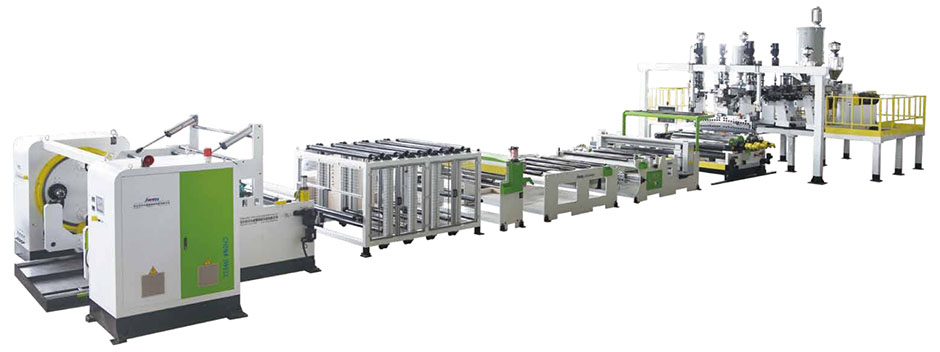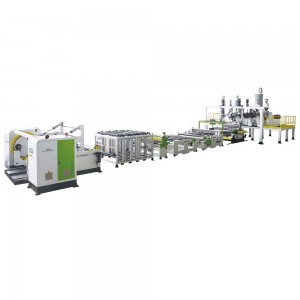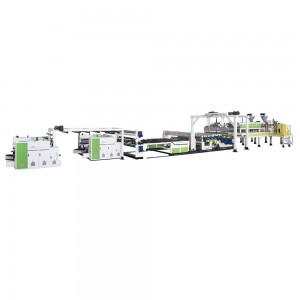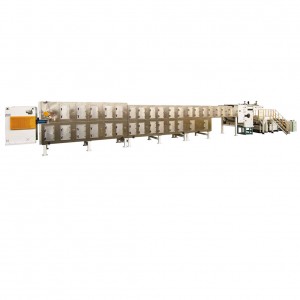PP/PE/PA/PETG/EVOH Multilayer Barrier Sheet Co-extrusion Line
Main Technical Parameter
| Line model | Extruder model | Products width | Products thickness | Design extrusion output |
| 7 layers co-extrusion | 120/75/50/60/75 | 800-1200mm | 0.2-0.5mm | 500-600kg/h |
| 9 layers co-extrusion | 75/100/60/65/50/75/75 | 800-1200mm | 0.05-0.5mm | 700-800kg/h |
Note: The specifications are subject to change without prior notice.

Market status of EVOH packaging applications
In the field of cold chain food packaging, people used metal or glass materials as food packaging to effectively isolate the penetration of various gas components inside and outside to ensure the quality of the contents and commodity value. Because there are three major factors that cause food spoilage: biological factors (biological enzyme reactions, etc.), chemical factors (mainly oxidation of food components) and physical factors (hygroscopic, drying, etc.). These factors play a role in environmental conditions such as oxygen, light, temperature, moisture, etc., which cause food spoilage. Preventing the deterioration of food is mainly to inhibit the proliferation of microorganisms in the food, prevent the oxidation of food components by oxygen, and prevent moisture and maintain the original flavor of the food.
Ethylene-vinyl alcohol copolymer, referred to as EVOH, is known as the world's three largest barrier resins together with polyvinylidene chloride (PVDC) and polyamide (PA) [2]. EVOH can greatly inhibit the intrusion of oxygen in the air into food, thereby inhibiting the production of toxins and other harmful substances due to the proliferation of microorganisms, and can also prevent composition changes caused by oxidation, while maintaining fragrance and preventing external odor pollution. Moreover, the lack of moisture barrier properties can be compensated by other polyolefin layers. Therefore, EVOH multilayer packaging materials can effectively prevent food spoilage and extend shelf life. In addition, it is easy to process and form, and has good environmental protection performance. Due to the excellent gas barrier properties, transparency, processability and solvent resistance of EVOH resin, its application fields are getting wider and wider, and the demand is also growing rapidly.
High barrier EVOH resin
1. Material properties
The barrier properties of EVOH The barrier properties of polymer materials refer to the shielding ability of products to small molecular gases, liquids, water vapor, etc. Currently commonly used resin varieties with good barrier properties include: EVOH, PVDC, PAN, PEN, PA and PET.
2. When EVOH is used as a high barrier material, it usually adopts a multi-layer composite structure. Commonly used composite materials are: PP, HIPS, PE, EVOH, AD, and AD is the adhesive in the structure. The multi-layer composite structure can give full play to the properties of each material, improve the water resistance of EVOH, and obtain a high-barrier material with excellent comprehensive properties. Most of them were used in flexible packaging in the past, but composite resins such as PP, PE, and PA are not easy to punch due to their good toughness and poor rigidity, which limits their application in the field of rigid packaging, especially in online filling products. Impact-resistant polystyrene HIPS has good rigidity and excellent molding properties, suitable for punching and suitable for hard packaging materials. Therefore, it is particularly urgent to vigorously develop EVOH high-barrier composite materials suitable for hard packaging.
Due to the poor compatibility between EVOH resin and HIPS resin, and the large difference in resin rheology rate, the bonding strength between the substrate and EVOH, the requirements for the tensile properties of EVOH during secondary molding, and the EVOH layer distribution during calendering to produce composite sheets The uniformity of composite materials are all key issues affecting the performance and use of composite materials, and are also difficult problems that need to be solved when producing this type of composite materials.
The key to the multi-layer co-extrusion technology is the adhesive (AD). The composite packaging materials of EVOH usually include PPEVOH, but PP and EVOH cannot be directly thermally bonded, and an adhesive (AD) must be added between PP and EVOH. When selecting the adhesive, it is necessary to consider the adhesive of PP as the base material, the second is the matching of the melt viscosity of PP and EVOH, and the third is the requirement of tensile properties, so as to avoid delamination during secondary processing. Therefore, the co-extruded sheets are mostly five-layer co-extruded sheets (PPADEVOHADPP). /AD/EVOH/AD/R/PP, the outermost layer is PP new material, and the other two layers are PP crushed recycled material R(PP). Asymmetric structure can also be used, and other materials (PE/HIPS, etc.) extruders can be added for co-extrusion. The principle is the same, and the same multi-layer co-extrusion method can be achieved.
Application
EVOH material has good barrier properties. Through co-extrusion technology with PP, PE, PA, PETG and other materials, it can be processed into 5-layer, 7-layer, and 9-layer high-barrier lightweight packaging materials, mainly used in aseptic packaging, jelly drinks, dairy products, chilled fish and meat products packaging etc. In the non-food aspect, it is used in pharmaceutical, volatile solvent packaging and other fields, with excellent barrier properties, which greatly improves the shelf life of products.






